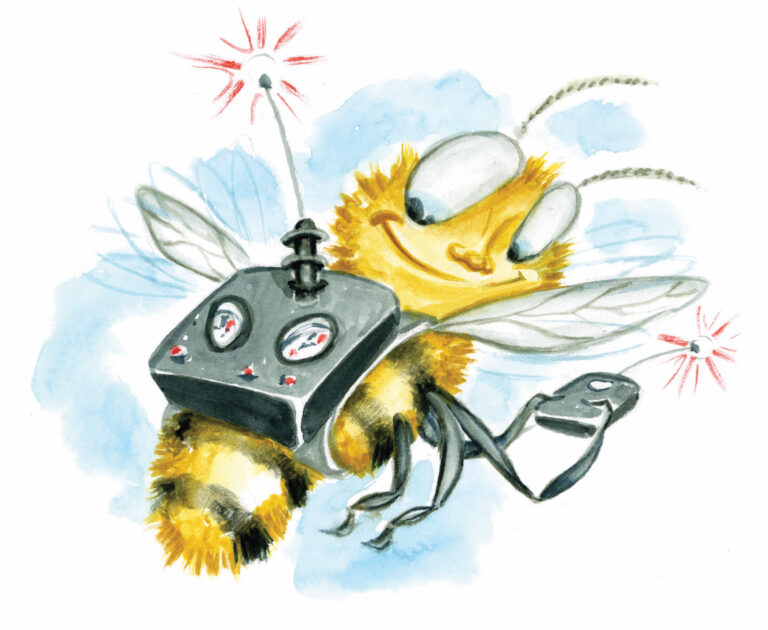By Susan B. Barnes, Larry Bleiberg, Caroline Sanders Clements, Gabriela Gomez-Misserian, Jordan P. Hickey, Lindsey Liles, T. Edward Nickens, Charlie Scudder, and Amy Brecount White. Illustrations by Tim Bower.
On The Wire
An innovative multidisciplinary artist, Hayward Oubre created dynamic, colorful found-material wire sculptures, sprawling geometric paintings, and figurative prints conjured from his experience as a Black Southerner, as well as his military service as a structural draftsman, and fascination with NASA and the Space Race. Beginning October 4, the Birmingham Museum of Art will host Hayward Oubre: Structural Integrity, the first major retrospective of his work. The New Orleans–born artist, who died in 2006, devoted just as much time to the classroom, sharing his genius with generations of students at Alabama State University and Winston-Salem State University. “He had a really clear vision of what he could contribute,” says Katelyn D. Crawford, the museum’s William Cary Hulsey Curator of American Art. At the show, a catalogue of reflections from the artist’s family and former students honors Oubre’s outsize legacy. “So much lives in communities, not in museums,” Crawford says. “This show is trying to tell a fuller story of art in Alabama.”
Island Connections
As the crow flies, the Marshall Islands lie roughly 6,180 miles from Arkansas. Which is to say, a landlocked state isn’t exactly the first place you would expect to host an introduction of sorts to a Pacific Ocean–based culture. And yet, the new exhibition Navigating Lolelaplap, the Marshallese name for the islands, is doing just that—with good reason. “Guess what? The people are here,” says Melisa Laelan, the founder and chief executive director of the Arkansas Coalition of Marshallese. The exhibition, which opens October 19 at Crystal Bridges in Bentonville, does offer a window to the past—explaining how since the 1980s, nearly a quarter of the world’s Marshallese population, displaced by sixty-seven atmospheric nuclear bomb tests conducted by the United States, have found their way to Northwest Arkansas. But it also encompasses the current moment. Every item, whether a woven mat made from pandanus leaves or a contemporary dress emblazoned with grid lines suggestive of maritime navigation, reflects not just a culture but a people. “The emotions, the feeling of attachment to our culture, to our identity, to our ocean,” Laelan says, “everything that’s in that exhibition is really what makes this Lolelaplap.”
Where There’s Smoke
At the turn of the twentieth century, Tampa’s Ybor City was considered the Cigar Capital of the World, with some two hundred factories rolling more than a million cigars a day. Today a single factory still produces them in Ybor City: J.C. Newman Cigar Co. The fourth-generation owner, Drew Newman, says his great-grandfather and grandfather moved the family business from Cleveland, where they started in 1895, to Ybor City in 1954. The company is celebrating seventy years in El Reloj, its historic clock tower factory, this year. Not ones to rest on their tobacco leaves, Newman and his team are enhancing the visitor experience—renovations are underway to transform a neighboring building into a restaurant, cigar club, and eleven-room inn. They’re also relocating an antique tobacco barn from North Florida to the corner across from El Reloj, where a small urban tobacco field will share details of the process with visitors, from growing seedlings to harvesting, fermenting, and drying leaves before the pros roll them into smokes. As Luis Gonzalez, a torcedor, or cigar roller, puts it: “We are part of the history keeping this beautiful tradition alive.”
Rural Retreat
In the twenty-five years since Barnsley Resort opened, the three-thousand-acre estate in Adairsville has preserved plenty of historical and natural treasures: boxwood parterres; miles of wooded hiking trails; the ruins of a circa 1840s Italianate manor built by the resort’s namesake, Godfrey Barnsley. “We also have Conifer Hill, a section of meadow showcasing an impressive variety of evergreen and conifer specimens,” says Barnsley’s president, David Friederich. “Godfrey Barnsley would be at different ports of call and bring back trees from his travels.” At the Swine & Wine Weekend (October 25–26), spirited tours take guests through that history, while dinners and tastings nod to the present. Between sessions on the clays courses or rounds on the Jim Fazio–designed golf course, Carey Bringle of Nashville’s Peg Leg Porker will smoke a whole hog and help lead a bourbon tasting.

Give Up the Ghosts
Next door to Robbie Morgan’s office in Lawrenceburg stands the nearly century-old Anderson Hotel building, where in one of its past lives as a flophouse, more than a dozen people met untimely deaths. Now home to a seasonal haunted house, the Anderson claims a stop on Kentucky after Dark, a spooky statewide trail linking paranormal hot spots, cryptid habitats, and other spine-tingling locales. “We have all these creepy sites,” says Morgan, Lawrenceburg’s tourism director. Launched last year with money from the federal American Rescue Plan Act, the route leads folks to such places as the supposed stomping grounds of the Goatman, a creature said to prowl under a bridge in Louisville; an alien invasion site near Hopkinsville; and Sassy Trash, an allegedly haunted vintage and antique shop in Harlan. Morgan says she’s not quite sure why Kentucky seems to overachieve in the creepy department, but it could be the state’s mining heritage. “Some say when you open up the crevices of earth for coal mining, you release a whole lot of old gods.”
The Butterfly Effect
Maryland’s official insect, the Baltimore checkerspot, wears its state pride on its wings. “It looks like you took our flag and stamped it on a butterfly,” says John Garrison, a biologist and the conservation director at the Susquehannock Wildlife Society (SWS) in Harford County. The insect’s range reaches up to Canada, and it was once found all over Maryland. But degradation and loss of the butterfly’s wetland habitat, coupled with climate change and overgrazing by deer, mean the remaining populations now inhabit just twenty sites in western and central parts of the state. To help, the SWS is restoring wetlands by removing invasives and planting the butterfly’s host plant, white turtlehead, as well as bringing in caterpillars to try to jump-start new populations. One such site sits near the new SWS wildlife center, opening this fall; there, visitors can see exhibitions on the butterfly’s life cycle and observe checkerspots in rearing pens. “It would be a tragedy to lose our state insect,” says Scott McDaniel, the SWS’s cofounder and executive director. “They’re a beautiful species, and we want people to connect with them.”
Fit for Kings
When B. B. King’s hearse drove down Mississippi’s legendary Blues Highway to his final resting place in Indianola, it stopped at Tunica’s Blue and White Restaurant. “His family and entourage all came in for a meal,” says Joe Weiss, a former owner. During the blues icon’s lifetime, the café was his favorite stop along U.S. Highway 61, and he wasn’t alone. The former Pure Oil gas station café, which marks its centennial this year, has attracted generations of diners. Weiss is working with the current owners to keep the tradition alive, bringing in retired and former cooks to coach new employees on the café’s recipes, which rely on fresh vegetables and nostalgic flavors, from hand-trimmed turnip greens to coconut cream pie. The Blue and White draws crowds for its Fry-Friday buffet with chicken, catfish, and salmon patties. Tunica farmer and hunting guide David Melton can’t remember a time when he didn’t eat there. “I probably sat in a damn high chair throwing water and ice around,” he says. And he’s glad to see it thriving. “It’s like walking into Sunday dinner at your grandmother’s house. I can’t say I grew up there, but I did, I guess.”
Rescue Rangers
The 1874 Chicamacomico Life-Saving Station in Rodanthe is “the most complete restoration of a life-saving station in the United States,” says John Griffin, the volunteer executive director of the site’s historical association. Chicamacomico, which means “sinking down sand” in Algonquin, is the only spot that stages a costumed, historically accurate reenactment of the rescue drill that the station’s surf team performed regularly to prepare for shipwrecks along the “graveyard of the Atlantic,” a history that taps into pre–U.S. Coast Guard days. The dramatic scene features a simulated tall ship’s mast, a small cannon lit to launch the shot line, a breeches buoy (a diaper-like seat for the rescue) that rides the line, and a volunteer child rescuee. October 12 and 13 mark the station’s 150th anniversary, and attendees can explore a Coast Guard helicopter, watch a live ocean rescue by another helicopter, and listen as the Ancient Keeper, the Coast Guard’s most senior master chief, gives a commemorative speech.

Putting for Glory
No knocks on azalea blossoms and green jackets, but there’s more than one Masters tournament in the South. Every fall since 1997, the nation’s top putters have descended on North Myrtle Beach for the ProMiniGolf Master’s (October 8–12). Action centers on the Hawaiian Rumble course, eighteen holes that lead players through tropical foliage centered around a towering faux volcano that growls and shoots out flames every twenty minutes. The Rumble’s owner, Bob Detwiler, a former tennis coach at Myrtle Beach High School, serves as president of the U.S. ProMiniGolf Association, which sponsors the tournament. He’s particularly proud of hole sixteen, an unforgiving layout that often punishes players by sending missed putts rolling right back to the tee. Indeed, the event is hardly a walk in the park. Reigning champion Gary Hester of Calabash, North Carolina, has been competing since he was a teenager. He says each tournament requires hours of practice time on the greens: “They play different in the morning and afternoon. Some carpets play faster when they’re dry. It’s professional, and we do take it very seriously.” Detwiler, who expects a record of more than eighty players to vie for $25,000 in prize money in this year’s Master’s, says professional miniature golf is just taking off. “You take the NFL or MLB—they’ve been doing it over a hundred years. Give us some time and we’ll be just as big.”

Reeled In
When the sun sets on October 5, the Stateline Drive-In theater just south of Elizabethton will host the world-traveling Fly Fishing Film Tour 2024. The F3T, as the cool kids call it, includes a thrilling roster of fly-fishing films that cover the globe, as well as raffles, auctions, a cookout, and local fishing guides on hand. Sponsored by the Blue Ridge Guide Association and the Overmountain Chapter of Trout Unlimited, the effort will raise funds for both organizations and call attention to conservation on the South Holston and Watauga Rivers, large dam tailwaters that offer some of the South’s best trout fishing. The drive-in theater by the Doe River has been an East Tennessee landmark since 1947, showing family-friendly flicks on weekends from April through September. But this special off-season event highlights its storied roots, says Matt Maness, a fly-fishing guide and vice president of the guide group. “While we work on conservation initiatives from water quality to public access,” he says, “this event is about bringing people together.”
All Fired Up
Pretty much everything at chef Tiffany Derry’s new Dallas-area restaurant, Radici Wood Fired Grill, gets cooked over the restaurant’s namesake flames. No gas or electric burners here. “I wanted to kiss the fire and play with it and just have this aroma when you walk in the building,” she says. Derry and her business partner Tom Foley designed the menu around decidedly Italian dishes: a seafood salad with prawns, calamari, and octopus; a Kurobuta pork chop with charred radicchio, grilled Borettane onions, and balsamic glaze. That’s not to say there’s no crossover with Derry’s long-beloved spots, Roots Chicken Shak in Plano and Roots Southern Table, which is located along the same stretch of road as Radici, in Farmers Branch. She says that she sees some patrons order the cast-iron cornbread to go at Roots Southern Table, walk it down the street, and dip it into Radici’s cannellini beans cooked with Parmesan rind, olive oil, and sage. She gives the coupling her seal of approval: “It’s like simple perfection.”
Serenity Found
When hikers trek into the new Biscuit Run Park near Charlottesville, it will mark the final step of a long journey. Nearly twenty years ago, the 1,190-acre forested property was slated to become a residential community, but plans fell apart with the Great Recession, and eventually the land ended up with Albemarle County to develop as a park. Now Biscuit Run—within a few miles of the University of Virginia, Monticello, and wineries—will attract tourists as well as locals, says Chief of Parks Planning Tim Padalino. “There’s a big swath of pristine forest,” he says, “and there are pretty rugged foothills.” Other natural highlights include a hemlock grove, beaver dams, rare orchids, and eight and a half miles of trails that at times trace the path of an eighteenth-century stagecoach road. Mountain biking trails and athletic fields will come in the future. Mark Lorenzoni, who cofounded Charlottesville’s Ragged Mountain Running & Walking Shop, led a community hike into the park. “It’s a gem,” he says. “Within two to three minutes, we were experiencing this privacy, this serenity. You get lost in the woods in a good way.”

Catching a Buzz
Attaching a radio transmitter to a bumblebee is a tricky business. “First, we chill the bees on ice so they slow down, hold them down on a piece of sponge so we don’t squish them, and shave some of the hair off their abdomen with a small razor blade,” explains Jakob Goldner, a conservation entomologist with the West Virginia Department of Natural Resources. Only then can biologists glue on the transmitter and its attached antenna, all of which weighs barely more than a grain of rice. Into early fall, black-and-gold bumblebees sporting their new gear will be buzzing around the state, tracked by biologists who want to know if they can follow the insects to their nests. But the real objective is to study the endangered rusty patched bumble bee, a species whose range once extended from the eastern United States up into Canada. Disease, habitat loss, climate change, and pesticide use have caused a decline of 70 percent or so across the little-studied insect’s territory. West Virginia’s Appalachian Mountains, particularly in Monongahela National Forest, shelter some of the remaining strongholds. “Now we are rushing to learn what we can about it,” Goldner says, including by developing the delicate art of bee tracking.


